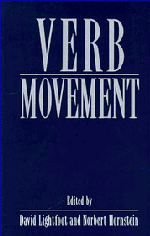Book contents
- Frontmatter
- Contents
- List of contributors
- Preface
- Verb movement: an introduction
- 1 Verb positions: evidence from Italian
- 2 Verb movement and word order in Arabic
- 3 Comments on the paper by Ouhalla
- 4 Some similarities and differences between Icelandic and Yiddish
- 5 Comments on the paper by Santorini
- 6 Finite verb movement in Scandinavian embedded clauses
- 7 Comments on the paper by Vikner
- 8 The Brythonic copula and head raising
- 9 A reinterpretation of evidence for verb movement in French
- 10 Two types of head movement in Romance
- 11 Comments on the paper by Roberts
- 12 Licensing heads
- 13 Comments on the paper by Koopman
- 14 Finiteness and head movement in early child grammars
- 15 Comments on the paper by Wexler
- References
- Index
5 - Comments on the paper by Santorini
Published online by Cambridge University Press: 03 May 2011
- Frontmatter
- Contents
- List of contributors
- Preface
- Verb movement: an introduction
- 1 Verb positions: evidence from Italian
- 2 Verb movement and word order in Arabic
- 3 Comments on the paper by Ouhalla
- 4 Some similarities and differences between Icelandic and Yiddish
- 5 Comments on the paper by Santorini
- 6 Finite verb movement in Scandinavian embedded clauses
- 7 Comments on the paper by Vikner
- 8 The Brythonic copula and head raising
- 9 A reinterpretation of evidence for verb movement in French
- 10 Two types of head movement in Romance
- 11 Comments on the paper by Roberts
- 12 Licensing heads
- 13 Comments on the paper by Koopman
- 14 Finiteness and head movement in early child grammars
- 15 Comments on the paper by Wexler
- References
- Index
Summary
Introductory remarks
In her paper, Santorini presents an ambitious and imaginative proposal, the first one in the literature, to unify certain syntactic differences between Icelandic and Yiddish. These differences have to do with long subject extraction across a complementizer, empty expletives in Spec of IP, and stylistic fronting, all of which are only possible in Icelandic. In commenting on the proposed account, I have deemed it most useful to stick to the perspective of a native speaker of Icelandic, not venturing too far into the intricacies of Yiddish, of which I know little. Further, I have endeavored to stay within the general theoretical framework assumed in the paper.
Santorini proposes to reduce the various differences discussed to a single factor, the location of the feature [+I] (from Rizzi 1990a). She assumes that this feature is in INFL in Yiddish, whereas it can be in either COMP or INFL in Icelandic. Nominative is assigned under head government by the highest [+I] category in the clause. The case-assigning property of the highest [+I] is also assumed to enable the head that bears it to license empty expletives. A third function of [+I], having nothing to do with nominative assignment, is voiding barrierhood, to account for long subject extraction.
It is presupposed in Santorini's paper that Icelandic and Yiddish are quite similar syntactically. It should be noted at the outset, however, that the similarity is probably less striking than one would gather from the list of common features at the beginning of the paper.
- Type
- Chapter
- Information
- Verb Movement , pp. 107 - 116Publisher: Cambridge University PressPrint publication year: 1994
- 2
- Cited by



